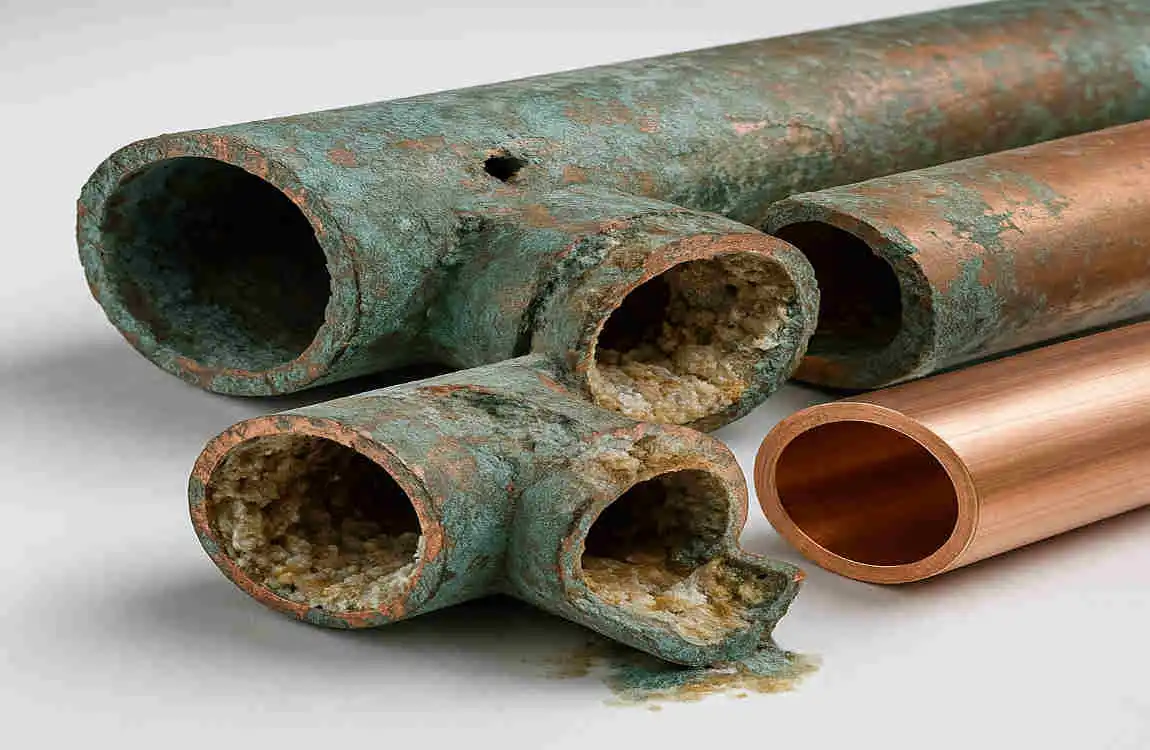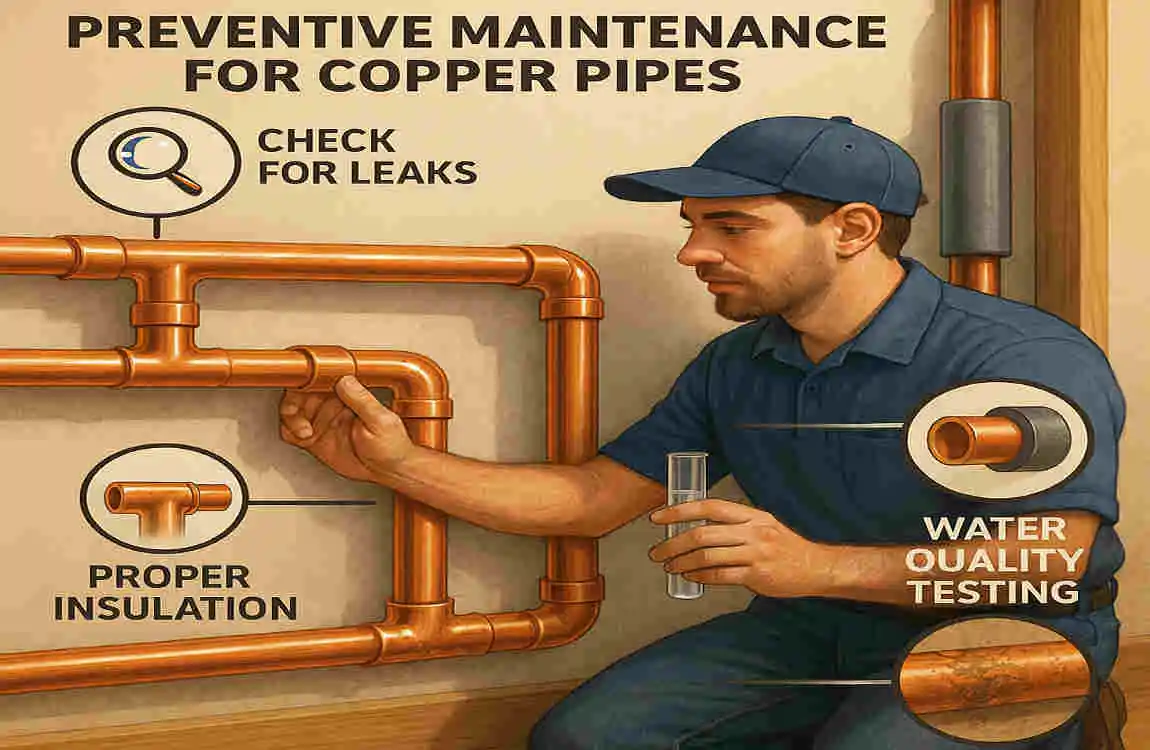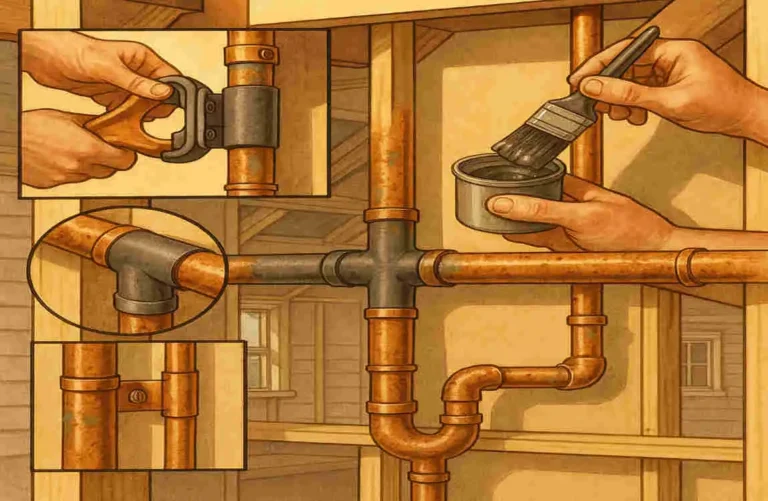Copper pipes have been a staple in homes for decades, known for their durability and resistance to corrosion. However, even the strongest materials can show signs of wear after 50 years. If you’re a homeowner with ageing copper pipes, it’s crucial to understand the importance of reinforcing and protecting them to maintain your home’s plumbing integrity.
Understanding the Condition of 50-Year-Old Copper Pipes

Common Issues with Ageing Copper Pipes
As copper pipes age, they can develop several common issues:
- Corrosion: Over time, copper can react with minerals in the water, leading to pitting and thinning of the pipe walls.
- Pinhole Leaks: These small leaks can develop due to corrosion or high water pressure, causing significant water damage if left unchecked.
- Thinning Walls: Continuous wear and tear can cause the pipe walls to thin, increasing the risk of rupture.
Signs Your Copper Pipes Need Reinforcement or Protection
Keep an eye out for these warning signs that your copper pipes may require attention:
- Discoloured Water: If your water appears blue or green, it could indicate copper corrosion.
- Low Water Pressure: Corrosion or leaks can restrict water flow, leading to reduced pressure throughout your home.
- Visible Damage: Look for signs of leaks, rust, or bulges on exposed pipes.
Benefits of Maintaining and Reinforcing Copper Pipes
Before considering a complete replacement, it’s essential to understand the advantages of maintaining and reinforcing your existing copper pipes:
- Cost-Effectiveness: Reinforcing and protecting your pipes can be more affordable than a complete replacement.
- Environmental Impact: By extending the life of your existing pipes, you’re reducing waste and minimising your ecological footprint.
- Preservation of Home Value: Well-maintained plumbing can increase your home’s resale value and appeal to potential buyers.
Assessing Your Home’s Copper Plumbing
Step-by-Step Inspection Process
To properly assess your 50-year-old copper pipes, follow these steps:
- Locate Your Pipes: Identify the location of your copper pipes, both visible and hidden within walls or ceilings.
- Check for Visible Damage: Inspect exposed pipes for signs of corrosion, leaks, or bulges.
- Test Water Quality: Collect water samples and have them tested for contaminants that may accelerate pipe deterioration.
- Assess Water Pressure: Use a pressure gauge to check if your water pressure is within the recommended range for your pipes.
Tools and Techniques for Checking Weaknesses and Corrosion
To effectively assess your copper pipes, you’ll need the following tools and techniques:
- Flashlight: Illuminate dark areas to spot any signs of damage or corrosion.
- Pipe Inspection Camera: For hard-to-reach pipes, a camera can provide a clear view of their condition.
- Ultrasonic Thickness Gauge: This tool measures the thickness of pipe walls, helping you identify areas of concern.
- Water Pressure Gauge: Monitor your water pressure to ensure it’s not putting undue stress on your pipes.
When to Call a Professional Plumber
While many aspects of pipe assessment can be done DIY, there are situations where it’s best to call in a professional:
- Inaccessible Pipes: If your pipes are hidden within walls or ceilings, a plumber can use specialised tools to inspect them.
- Complex Issues: If you discover significant corrosion or multiple leaks, a plumber can provide a comprehensive assessment and recommend the best course of action.
- Safety Concerns: If you’re unsure about working with your home’s plumbing system, it’s always safer to consult a professional.
Preparing to Reinforce Copper Pipes
Safety Precautions and Required Equipment
Before beginning any work on your copper pipes, take the following safety precautions and gather the necessary equipment:
- Turn Off the Water Supply: Ensure your water is completely shut off before starting any work on your pipes.
- Wear Protective Gear: Use gloves, safety glasses, and a dust mask to protect yourself from debris and potential hazards.
- Have the Right Tools: You’ll need pipe cutters, a propane torch, solder, flux, and various pipe fittings.
Necessary Materials for Reinforcement and Protection
To effectively reinforce and protect your 50-year-old copper pipes, you’ll need the following materials:
- Solder: Choose a high-quality lead-free solder to create strong, durable joints.
- Pipe Sleeves: These protective covers can be slipped over weakened sections of pipe to provide additional strength.
- Anti-Corrosive Coatings: Apply these coatings to the exterior of your pipes to prevent further corrosion.
Planning the Reinforcement Project
Before diving into the reinforcement process, take the time to plan your project:
- Timeline: Estimate how long the project will take, accounting for factors such as the number of pipes and their accessibility.
- Budget: Calculate the cost of materials and any professional services you may need.
- Scope: Determine which pipes need reinforcement and prioritise them based on their condition and importance.
Step-by-Step Guide to Reinforce Old Copper Pipes
Turn Off Water Supply
Before beginning any work on your pipes, locate your main water shut-off valve and turn it clockwise until it stops. This will prevent water from flowing through your pipes while you work on them.
Drain the Pipes
Open all faucets and let them run until no more water comes out. This will ensure your pipes are completely drained, making it easier to work on them without water interference.
Clean the Copper Pipes Thoroughly
Use a wire brush or sandpaper to remove any corrosion, dirt, or debris from the surface of your copper pipes. A clean surface is essential for proper adhesion of anti-corrosive treatments and solder.
Apply Anti-Corrosive Treatment
Once your pipes are clean and dry, apply an anti-corrosive coating to the exterior surface. Follow the manufacturer’s instructions for proper application and drying times.
Use Pipe Clamps or Sleeves for Reinforcement
For weakened sections of pipe, use pipe clamps or sleeves to provide additional support. These can be slipped over the damaged area and secured in place to prevent further deterioration.
Solder Leaks or Weak Spots
If you’ve identified any leaks or weak spots in your pipes, use a propane torch and lead-free solder to create a strong, watertight seal. Be sure to follow proper soldering techniques to ensure a lasting repair.
Add Protective Insulation
To prevent future damage from temperature fluctuations and moisture, wrap your reinforced pipes with insulation. This will help maintain the integrity of your pipes and extend their lifespan.
Test for Leaks and Water Pressure Post-Reinforcement
Once you’ve completed the reinforcement process, turn your water supply back on and check for any leaks. Use a pressure gauge to ensure your water pressure is within the recommended range for your pipes.
Best Products and Materials for Pipe Protection
When it comes to reinforcing and protecting your 50-year-old copper pipes, choosing the right products and materials is crucial. Here are some top recommendations:
Recommended Anti-Corrosion Sprays and Coatings
- Rust-Oleum 249325 Stops Rust Spray Paint: This spray paint provides a durable, long-lasting barrier against corrosion.
- Loctite Naval Jelly Rust Dissolver: This gel-based product effectively removes rust and prevents future corrosion.
Durable Pipe Sleeves and Clamps
- Oatey 38825 Pipe Sleeve: These sleeves are made of durable PVC and can be easily slipped over weakened sections of pipe.
- Eastman 61465 Pipe Clamp: These heavy-duty clamps provide strong support for damaged or weakened pipes.
Insulation Types for Temperature and Moisture Protection
- Thermwell Products Foam Pipe Insulation: This foam insulation is easy to Install and provides excellent protection against temperature fluctuations.
- Rubatex Armaflex Pipe Insulation: This rubber-based insulation is highly moisture-resistant and can help prevent condensation on your pipes.
Preventive Maintenance Tips for Long-Term Copper Pipe Durability

To ensure your reinforced copper pipes remain strong and durable for years to come, follow these preventive maintenance tips:
Regular Inspection Schedules
- Monthly Visual Inspections: Check exposed pipes for any signs of damage, leaks, or corrosion.
- Annual Professional Inspections: Hire a plumber to perform a comprehensive inspection of your entire plumbing system.
Water Quality Testing
- Test Annually: Have your water tested annually for contaminants that can accelerate pipe deterioration.
- Install a Water Filtration System: Consider installing a whole-house water filtration system to remove harmful substances before they reach your pipes.
Softening Hard Water
- Install a Water Softener: Hard water can contribute to pipe corrosion, so consider installing a water softener to reduce mineral buildup.
- Regular Maintenance: Follow the manufacturer’s guidelines for maintaining your water softener to ensure optimal performance.
Seasonal Care Routines
- Winterise Your Pipes: Before cold weather sets in, insulate exposed pipes and let a trickle of water run through them to prevent freezing.
- Summer Check-ups: In warmer months, check for signs of condensation or moisture buildup on your pipes and address any issues promptly.
When to Consider Replacement Instead of Reinforcement
While reinforcing and protecting your 50-year-old copper pipes can be an effective solution, there are situations where replacement may be the better option:
Indicators That Reinforcement Is No Longer Viable
- Extensive Corrosion: If your pipes show signs of severe, widespread corrosion, reinforcement may not be enough to restore their integrity.
- Multiple Leaks: If you’ve identified numerous leaks throughout your plumbing system, it may be more cost-effective to replace the entire plumbing system.
- Significant Thinning: If your pipe walls have become dangerously thin due to wear and tear, replacement may be necessary to prevent ruptures.
Cost-Benefit Analysis: Repairing vs. Replacing Copper Pipes
When deciding between repairing and replacing your copper pipes, consider the following factors:
- Age and Condition: If your pipes are nearing the end of their expected lifespan or show significant damage, replacement may be more cost-effective in the long run.
- Extent of Damage: If the damage is limited to a small section of pipe, reinforcement may be sufficient. However, if multiple areas require attention, replacement could be more efficient.
- Budget and Timeline: Compare the costs and timeframes for both options to determine which best fits your needs and resources.
Modern Alternatives to Copper Pipes
If you do decide to replace your copper pipes, consider these modern alternatives:
- PEX (Cross-Linked Polyethene): PEX pipes are flexible, corrosion-resistant, and easier to Install than copper.
- CPVC (Chlorinated Polyvinyl Chloride): CPVC pipes are durable, chemically resistant, and capable of withstanding high temperatures.
- Stainless Steel: Stainless steel pipes are highly corrosion-resistant and can last for decades with proper maintenance.

